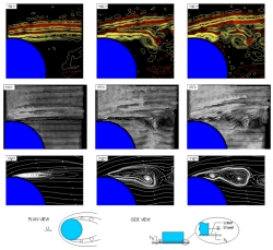You are here
Home ›Onset of Transition in the Near-Wake of a Cylinder in Shallow Water
Onset of transition in the near-wake of a cylinder in shallow water. At a sufficiently low value of Reynolds number and large value of stability parameter S, the near-wake of a cylinder in very shallow water is stable, as shown by the phase-averaged patterns of vorticity <ω>, velocity <V> and streamlines <Ψ> in the left column; patterns of <V> and <Ψ> are shown in a reference frame moving with the average velocity of the shear layer. The values of Reynolds numbers are Rehw = 270 and ReD = 4,400. The pattern of vorticity shows three layers of negative (yellow) and two layers of positive (red) vorticity. The negative layer closest to the surface of the cylinder is the classical separating shear layer, whereas the remaining four layers represent the footprints of the horseshoe (necklace) vortex system swept around the cylinder. In the middle column of images, the velocity is increased such that ReD = 5,200. A pronounced concentration of negative (yellow) vorticity is now evident in the shear layer from the cylinder, and distortion of the adjacent layers of vorticity is evident. In particular, bifurcation of the positive (red) layer occurs, and its lower branch terminates in a positive concentration. The major concentration of negative vorticity is distinguishable in the corresponding patterns of velocity and streamlines. Finally, the images in the right column correspond to a further increase to ReD = 5,800. Several distinct concentrations of negative vorticity are now evident. Small-scale concentrations of positive vorticity are also indicated. The major features of the negative concentrations are represented by the patterns of velocity and streamline topology. The ratio of the cylinder diameter D to the water depth h is D/h = 16. ReD = 4400, 5200 and 5800 corresponding to values of Reh = 270, 320, 360, and to values of the stability parameter S= cfD/hw =0.23, 0.20 and 0.18.
The unstable structure of the near-wake of a vertical cylinder, in a fully-developed, laminar free-surface layer, is characterized in relation to the unsteadiness of the horseshoe (necklace) vortex system about the upstream surface of the cylinder. A cinema technique of high-image-density particle image velocimetry allows space-time imaging of the critical regions of the flow and thereby wholefield representations of patterns of the flow structure, in conjunction with spectra and cross-spectra at a large number of points over the flow domain. Over the range of Reynolds number considered, the onset of large-scale, Kármán vortex formation remains suppressed in the near-wake, but increase of Reynolds number above a threshold value yields the onset and development of an instability mode that takes the form of a varicose, as opposed to a sinuous, pattern of vortices. It is related to the unsteadiness of the horseshoe (necklace) vortex system on the upstream side of the cylinder. The process of vortex formation in the near-wake is interpreted in terms of multiple, coexisting layers of vorticity due to both the horseshoe vortices and the vorticity layer associated with separation from the cylinder. Furthermore, it is demonstrated that when the near-wake is stable at a sufficiently low value of Reynolds number, application of external perturbations at the most unstable frequency of the separating shear layers can lead to destabilization of the near-wake to a sinuous mode of small-scale vortical structures. Moreover, perturbations applied at the expected frequency of large-scale Kármán vortex formation can also lead to destabilization of the near-wake in this mode. These types of perturbations lead to substantial alterations of the patterns of vorticity and streamline topology, as well as Reynolds stresses and entrainment velocities of the separating shear layers, along the bed, relative to patterns above the bed.

